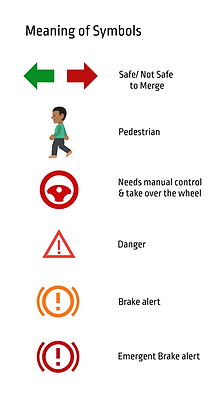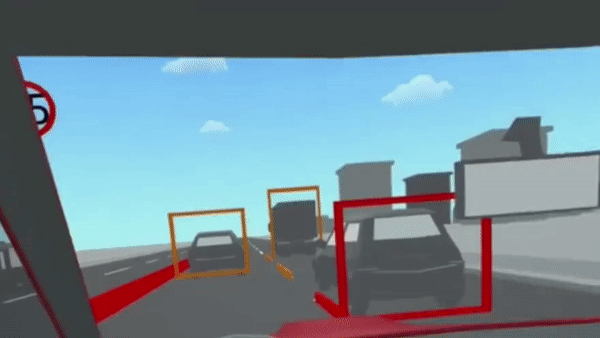

AVDA Design
My Role
Interaction Designer, UI Designer, Graphic Designer, UX Researcher
PROBLEM
As autonomous vehicles are quickly developing and being integrated into our streets, people are becoming more concerned about the reality of these vehicles. From news and media, it is suggested that the vehicles aren’t as capable as promised and may lead to severe consequences. Consequently, people are anxious about allowing the AV to take complete control over the vehicle because they’re not sure how the car is responding to their surroundings or if they’re able to detect dangerous situations.
If people feel unsafe about the vehicles' capabilities, they’re less likely to invest in autonomous vehicles or request a rideshare in one. How might we help users of AV technology trust their vehicle's performance?
SOLUTION
People need to understand how autonomous vehicles work in order to trust its performance.
AVDA is a user-interface that communicates the obstacles and dangerous situations detected by the sensors installed in autonomous vehicles.
When the vehicle is in semi-autonomous mode, the display will show these detections through symbols in order to aid the driver on the road.
When the vehicle is in full-autonomous mode, these detections will be reflected onto the windshield by highlighting what the vehicle is currently attentive to.
Stakeholder Value Exchange Diagram

Tablet Prototypes (during semi-autonomous mode)





Windshield Projection (during fully-autonomous mode)

HOW IT WORKS
AVDA would utilize information processed by the detection technology (radars and sensors) implemented in autonomous vehicles. This information would be displayed on an interface above the dashboard or in the middle, where traditional AC units are located.
Using digestible and intuitive symbols, AVDA will display only the most essential and convenient information to users.
In order to achieve a good design for safe driving practices, making information easily digestible and avoiding information overload are key components that we need to keep in mind. This is why AVDA's design uses symbols and limits too much information from bombarding the user.
VR Simulation of Prototype

CONSTRAINTS
01/
Requires many sensors, high cost
AVDA would utilize information processed by the detection technology (radars and sensors) implemented in autonomous vehicles. This information would be displayed on an interface above the dashboard or in the middle, where traditional AC units are located.
Using digestible and intuitive symbols, AVDA will display only the most essential and convenient information to users.
In order to achieve a good design for safe driving practices, making information easily digestible and avoiding information overload are key components that we need to keep in mind. This is why AVDA's design uses symbols and limits too much information from bombarding the user.
02/
System Maintenance
The system may often require maintenance and examination. The vehicle is implemented with high technological AV assistance. In order for AVDA's functionality to remain sturdy and safe, the system may need to be repaired and a cloud system may need to be implemented for occasional updates.
Video

Poster

Reflection
Through this project, I learned the whole process of branding and campaigning for the product, including creating videos and posters for stakeholders and interested groups. The process of branding in product design allows me to think and learn different ways to package the product effectively and uniquely to attract stakeholders. To create an effective and appealing produce, it's significant to broaden our scopes of stakeholders and consider their needs in a wholistic way. The "Stakeholder value exchange diagram" is very informative to showcase the interconnected needs and interests across relevant stakeholders. To accurately pinpoint these needs, immersive research into stakeholders' lives and contexts is crucial.